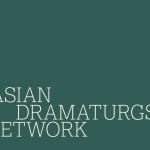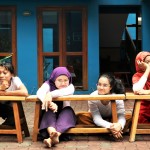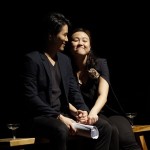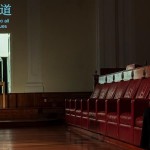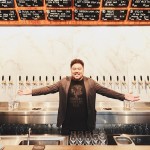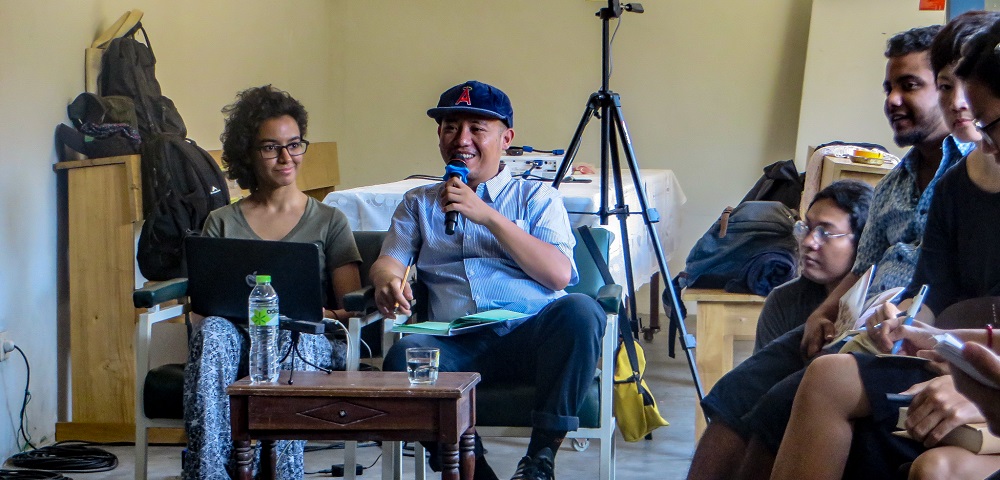
Our rapporteur for the ADN Lab 2018, Akanksha Raja (left), worked closely with translator Fiky Daulay (centre) to capture the goings-on of the Lab.
How do you listen? It’s such a seemingly facile act, as instinctive and unconscious as breathing – but when was the last time you listened mindfully, not just with your ears, but with all your senses and your energy? I got to do plenty of listening in my role as rapporteur at the Asian Dramaturgs’ Network Laboratory (ADN Lab) 2018 programme, which took place in Yogyakarta, Indonesia. From 7 to 10 September, two groups of participants (Lab 1 and Lab 2) worked on the dramaturgy of two very different performance projects in their early developmental stages. My role was to observe and document the proceedings in Lab 1 at Teater Garasi through text and image.
The participants of the Lab comprised about 30 arts practitioners from eight countries. The predominant spoken languages were Bahasa Indonesia and English, which meant that for those fluent in only one or the other – or those for whom neither was their native language – attentive listening and reliance on good translation were crucial.
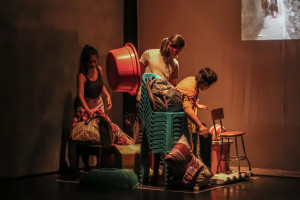
Lab 1 participants explored real-life stories of displaced residents from an estate in Bandung.
In his opening keynote on the first day of the Lab, renowned performance academic Rustom Bharucha touched on the importance of collaborative and collective energy in the dramaturgical process. He also emphasised that the practice of translation is an integral part of the process. That’s especially crucial when working within two contexts relevant to performance-making in Asia: the intracultural, which refers to the diversity and plurality of identities present within a certain culture, and the multilingual, which gives rise for the need for translation.
Rustom’s point about the importance of translation was one that stuck with me through my time documenting all the discussions that took place. In Lab 1, Indonesian translator Fiky Daulay worked at rendering almost everything that was being said in English and Bahasa Indonesia. While his translation was not verbatim, it was apparent that he was paying close attention to the context of what was being said and where the speaker was coming from, which he attempted to communicate with the rest of the group. Where he encountered difficulties, the other multilingual participants in the group – Alia Swastika and Lisistrata Lusandiana – would step in to clarify.
A key factor in the translation process is mindful listening. As ADN’s co-director Charlene Rajendran shared on the first day in a panel discussion, one of the dramaturg’s most important roles is to offer a critical “listening presence”. She emphasised the need for conscious listening not just to the aural, but to “spaces, sounds, movements, people, energies” – an acute and sensitive act of listening that involves the whole body. She alluded to Singaporean director Kok Heng Leun’s proposal of a “listening aesthetic”, a sensitivity to hearing what is spoken as well as unspoken or conveyed in non-auditory ways. Rustom similarly mentioned the benefits of listening with the body in his keynote, especially in a multilingual context, where the body can pick up nuances and feeling without necessarily having to understand the language that is being spoken.
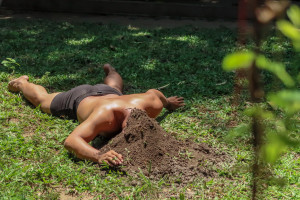
Participants in Lab 2 experimented with ways of performing the theme of death.
On occasion, Fiky’s translation was also an embodied one: for example, during a rehearsal, one of the performers led the audience to a corner of the performance space where he recounted, in Bahasa Indonesia, an intimate story about his family. He spoke in a softened tone that quivered with emotion and vulnerability. In translation, Fiky did not merely relay the performer’s words in English, but also took on the same softened tones approximating the expressiveness of the performer. It was through closely observing Fiky’s process – as I had to, since I needed to document every conversation – that I got to witness how the act of translation is very much a creative process, or even a dramaturgical one.
At the beginning of the second day of the Lab, Fiky suggested that instead of translating every single line, he would only do so “if those who need translation raise their hand”. He proposed that, in order to save time, he would wait for people to have an entire conversation before translating, rather than parsing line by line. In response, Rustom and several members of the ADN team asserted that they preferred not to be in a hurry, and that despite the time that translation takes, they felt it was useful and worthwhile. It struck me how everyone was sensitive to the delicate and sometimes time-consuming process of translation, and frequently slowing their talking speed and halting at regular intervals to accommodate the process. In the silence between a speaker speaking and Fiky rapidly processing what was being said, I felt the listening presence that Charlene spoke of when discussing the role of the dramaturg. There was as much attention paid to that laborious but necessary process of translation, as it was to the performance-making dramaturgy, which was ostensibly our main focus.
I believe an important aspect of both the acts of listening and translation is patience. Lab 1 began with the artists emphasising that they were “not in a rush to make a product”. They asserted that they were comfortable with taking their time to work through their process. This set a pleasantly unhurried and relaxed pace over the two days of Lab activities. Perhaps it’s because I’m so used to fast-paced and results-oriented Singapore, but I felt a distinct peacefulness in the laid-back environment at Teater Garasi, even on occasions such as when lunch arrived late and delayed a rehearsal. I rarely sensed pressure or tension in the air over those intensive two days
The final showcase of works by the artists from both Labs took place on the final evening at Teater Garasi. It was a rewarding experience after the rigorous rounds of rehearsals and conversations, through which the artists managed to finesse several scenes.
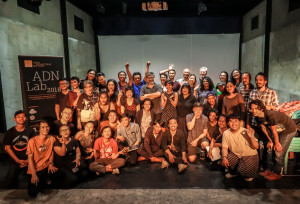
There were around 30 participants from eight countries at the ADN Lab.
When I was invited to be a participant in the ADN Lab a couple of months earlier, I was excited. As a young arts writer finding my own critical voice, I’m interested in ways of thinking and writing about performance-making processes that go beyond a passive recount of what is performed on stage, and into explorations of how art-making relates with broader social, political and cultural concerns and contexts. The Lab offered an avenue to be part of such processes and conversations. What I learnt – or re-learnt – as a rapporteur was more visceral: what it means to listen, even to words in an unfamiliar language. My most immediate takeaways from the Lab lie more in the value of these invisible, liminal processes of listening and the other subtle creative ones that happen in the surrounds of the performance-making space, which bring home again the notion that dramaturgy is alive even in the apparently mundane.
By Akanksha Raja
Published on 28 September 2018
The Asian Dramaturgs’ Network Laboratory 2018 took place from 7 to 10 September 2018 in Yogyakarta, Indonesia. Find out more about the event here.
Akanksha Raja is an arts writer from Singapore. She has been writing reviews on theatre (and occasionally visual art) as part of the editorial team at ArtsEquator.com since its launch in 2016, and is an alumnae of the Points of View Performance Writing workshop organised by the Asian Dramaturgs’ Network in 2018.

